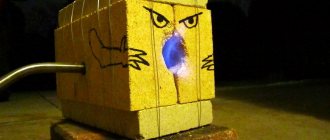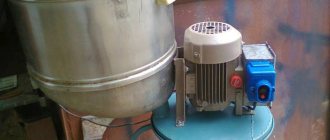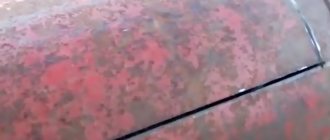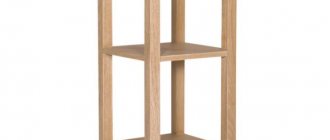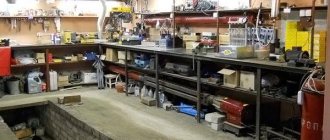[Forging pneumatic hammer] is used for processing metal products by chopping, broaching, bending, and knocking out various holes.
Its use makes it possible to perform stamping using backing dies; working with closed dies is not recommended, since hard blows from a forging hammer may cause the headstock to be repaired.
The peculiarities of the functioning of a pneumatic forging hammer consist in the use of air, which enters the compressor of the equipment from the environment.
The incoming air, during the reciprocating action of the compressor piston, is compressed and then discharged.
The piston is driven by a drive-type electric motor using V-belts.
The working chain device also includes: a gearbox, which helps reduce the level of rotation of the crank, a crank shaft and a connecting rod.
If you pay attention to the presented drawings, you can see that the forging pneumatic hammer may not have a gearbox in the operating circuit.
In this case, the connecting rod and the crank shaft are connected, and the shaft is equipped with a flywheel.
A pneumatic forging installation differs from a steam-air forging equipment, in which the functioning of the falling elements is supported by steam or compressed air.
A pneumatic hammer is a device in which air serves as an elastic air cushion.
Thanks to it, the movement from the compressor piston to the worker is not transmitted rigidly.
The number of blows that a forging pneumatic hammer can perform in 60 seconds corresponds to the number of revolutions made by the crank shaft.
The forging pneumatic hammer can be equipped with falling elements with different weights, from 50 to 1000 kg. In this case, the shock wave can range from 0.8 to 28 kJ, speed from 5 to 7.5 m/s, multiplicity - 12%.
The operation of the compressor piston is carried out by a stroke with one degree of freedom, which is determined by the position of the angle of rotation of the crank shaft.
Video:
The working piston is installed in the lower position, the compressor piston is in the upper position, and the firing pin is located on the forging.
IMPORTANT TO KNOW: Assembling a mini metal lathe with your own hands
Thus, both cavities of the compressor cylinder are combined with the atmosphere with an initial pressure corresponding to atmospheric pressure.
A similar pressure is also established for the cavities of the working cylinder of a forging hammer, since they communicate through taps with the cavities of the compressor cylinder.
If you have a lot of experience and the necessary materials, then making a pneumatic forging hammer with your own hands will not be difficult.
Having such blacksmithing equipment available, you can decorate your own home in an original way or start a profitable business.
How to assemble a pneumatic forging device, the instructions from the video material will tell you about this in more detail.
But to assemble a simple blacksmith’s hammer, you don’t need much experience. Homemade equipment can operate using a foot or electric drive.
In the latter case, the drive is connected to the electric motor using gears.
Working principle of a forging hammer
Forging hammers are relevant for small forges that specialize in orders for the manufacture of metal products:
- elements for furniture created by artistic forging;
- small equipment for hunting and fishing;
- memorable souvenirs, etc.
The operating principle of this equipment is based on the use of dynamic impacts of the working body - the rod, connected to the striking part of the machine - the woman, as well as devices for controlling the impact force.
The device of a lever forging hammer.
Other required structural elements of a spring forging hammer are described below:
- woman connected to the piston;
- a base fixed to a base;
- a bed with guides for moving units fixed on it;
- drive equipment;
- shield fencing providing the operator with a high level of safety;
- electrical equipment;
- Pneumatic hammers also have a compressor cylinder in their design.
The first models of such equipment were equipped with a foot or hand drive; modern products have a convenient control system that minimizes the effort on the part of the blacksmith.
Let us describe the principle of operation of the device:
- the workpiece is placed in the lower part of the hammer;
- the device is adjusted to the current impact frequency and set in motion;
- when the hammer is activated, the driven upper part of the structure hits the metal workpiece;
- the dynamic impact on the metal workpiece is carried out until it acquires its current shape.
The principle of operation of a diesel hammer is to convert the reciprocating movement, which is performed by the crank mechanism, into a similar movement of the piston. This provides the master with the opportunity to perform many operations with its help.
To come in
Already registered? Sign in here.
There are currently 0 users on the page
There are no users viewing this page.
The forging hammer is one of the most specific devices in any forge shop. With its help, workpieces are deformed in hot and cold states, giving them the required shape. Let's look at the operation of this unique equipment, what actions in blacksmithing can be performed with a forging machine, and what the cost of forging operations is.
This information will primarily be needed by those who are currently deciding which forging hammer to buy and how to then use it correctly. It is very important to study their technical characteristics in the models under consideration, in order to then make the optimal choice of equipment using a comparison method.
With the help of blacksmith hammers you can do:
- bending of metal blanks;
- stretching or lengthening of products;
- sewing holes of different diameters in them;
- upset or compression of workpieces;
- chopping workpieces into pieces.
Most types of forging hammers are capable of performing all of the above work; these machines can be easily classified according to their design properties and performance qualities.
Types of hammers
Longitudinal section of hammer MA4132.
According to the type of substance used in the compressor cylinder, the following forging hammers are distinguished:
- steam-air units operate using steam or atmospheric air;
- hydraulic and hydrostatic models use the force of fluid under pressure;
- gasoline hammers operate on the principle of internal combustion engines;
- gas ones use liquefied gas;
- electromagnetic hammers for forging use the energy of electric and magnetic fields;
- mechanical hammers are launched by the physical effort of the master and are used little in comparison with other models of similar equipment;
- spring-spring models work due to the fact that the spring accelerates the fall of the piston down;
- pneumatic ones use the force of gas under pressure during operation.
Separately, it is worth noting the forging pneumatic hammer with a pneumatic cylinder. This structure eliminates the need for the craftsman to use additional energy sources and make the structure heavier. When the forging hammer strikes the workpiece, its shape changes according to the planned working pattern.
Mechanical
A mechanical forging hammer is an old device in terms of its operating principle, developed and put into practice several centuries ago.
The basis of its design is a mechanism that supplies force from the human muscles to the hammer. It was only many years later that the first models with water and steam powered drives were designed.
The main working part of a mechanical hammer is constructed of a lever with a hammer on one side and a massive counterweight on the other. It is installed on a shaft that can swing under the influence of a pedal or lever.
Mechanical hammers have a manual control method, so such models can be made on your own.
However, it is worth remembering that the efficiency of such equipment in comparison with more modern models is quite low. And the dimensions of the mechanics are quite impressive, which does not allow them to be used in tiny forges.
Pneumatic
A pneumatic forging hammer is classified as forging equipment that is capable of performing a large range of operations, including twisting, cutting and forming metal blanks.
The design of this unit is complemented by an oil pump that lubricates the working cylinders with a special compound, and the hammer of the forging pneumatic hammer gives it maximum stability.
Drawing of a pneumatic hammer.
Hammers are installed in single quantities and are equipped with an individual compressor unit. They are not characterized by a large mass of falling parts, therefore they can be used for forging small-sized products.
Often, an air hammer is equipped with a C-shaped frame, fastened together for rigidity by means of side posts. The stamping area of the pneumatic hammer is open on three sides, which greatly simplifies its maintenance.
The pneumatic forging hammer is controlled using a hand lever or pedal and can be used in two directions:
- for artistic forging, units whose weight does not exceed 75 kg are suitable;
- in production: MPCh 150-2000 kg.
The advantages of equipment of this type are as follows:
- energy intensity;
- high sensitivity when adjusting operating modes;
- simple controls;
- long service life.
The disadvantages of pneumatic hammers are decent dimensions, significant weight, and difficulty in transportation.
https://youtu.be/mq8UQp9oc04
Homemade hammer: super hammer
It will be easier to make a homemade blacksmith hammer for forging metal products if you divide all operations into several stages in the following sequence:
- preparing the base for installation of a forging hammer;
- designing a machine frame with springs;
- assembly of the working mechanism;
- installation of a homemade device.
Important! The design of a forging hammer largely depends on its type. It is possible to make a mechanical version at home, but constructing an electric or hydraulic hammer yourself is extremely problematic.
But before detailed instructions indicating how to make a blacksmith hammer, it should be noted the importance of creating a drawing of the future design.
Blueprints
You can make a forging hammer with your own hands in a workshop or garage. But before work, it is important to determine the current dimensions of the unit, describe all its component parts, which will subsequently make it possible to determine the weight of the product and its functionality.
To do this, you will need to draw up yourself or find on the Internet drawings and an assembly diagram of such a structure with a detailed description of all its parts.
On a note! It is easier to make mechanical-type forging hammers with your own hands, based on the classification of such units according to the nature of the force used.
Foundation
After creating the drawing, the forging devices proceed to forming the foundation. A homemade forging hammer must be installed on a flat area prepared in advance. This is necessary for the normal operation of the device and eliminating the risk of it tipping over during operation.
Electrical diagram of a forging hammer.
At the site where the structure will be installed, you need to dig a hole of the current size. Its bottom is carefully sprinkled with sand and crushed stone, watered and compacted. A reinforcing frame is mounted on top of the completed layer of sand cushion, for which reinforcement with a diameter of 12-14 mm is used.
It is extremely important not to forget about dressing, which is carried out every 250-300 mm.
The concrete solution is prepared in a ratio of 1:2:3, which will require the following materials:
- cement grade M400;
- crushed stone fraction 10-20;
- sand.
Filling should be done at a time, constantly compacting the mass. This will avoid the formation of voids inside the foundation.
At the final stage of manufacturing the base for a homemade hammer for forging into uncured concrete, it is worth installing anchor bolts, onto which the unit will subsequently be additionally fixed.
Frame
When assembling a homemade forging hammer, it requires a welding machine, with which the structure frame is assembled. It is made from profile pipes or other types of rolled metal that have high strength.
For additional stability of the product, you need to install spacers, as well as cross beams.
Hammer assembly
To begin work, you will need to assemble the frame of the unit and install it on the prepared base. The lower slides are fixed with anchor bolts and nuts, and the remaining guides and jumpers are welded to them using a welding machine.
The shaft is inserted into the racks, and then a lever with a hammer is attached to it. Drives with a pedal or lever are assembled in the same way.
A homemade forging hammer is equipped with an anvil. It performs an extremely important function, so its installation must be carried out with all responsibility. The anvil is fixed exactly under the lower position of the side, and a block of wood is placed under it.
It will act as a shock absorber when the hammer hits the anvil. The anvil is made from a piece of rail or channel, but preferably with a hardened front part. After the structure is assembled, it is painted.
Choosing a method for deforming hot metal
How to make a knife with your own hands at home
Free forging of small-weight products can be realized on the following forging machines:
- pneumatic hammer with electric drive;
- manual mechanical hammer (with a solid/flexible rod or spring version);
- screw hammer.
The latter option is characterized by the lowest speed of movement of moving parts, and therefore can only be used for forging highly plastic metals. All that remains is to make either a pneumatic hammer or a simple-action mechanical hammer.
Diagram of a forging hammer with a foot drive
Comparing the technological indicators of deformation, it is easy to come to the conclusion that the impact energy for a spring hammer is significantly lower than for a pneumatic hammer. In addition, the presence of el. control in the latter case will significantly reduce physical activity.
In contrast to the pneumatic hammer, the spring version does not require significant initial costs, and is also safer to use. Such a unit does not require electricity. motor, and this will make it possible to subsequently save on energy resources.
The main questions on how to make a homemade blacksmith hammer are discussed below.
